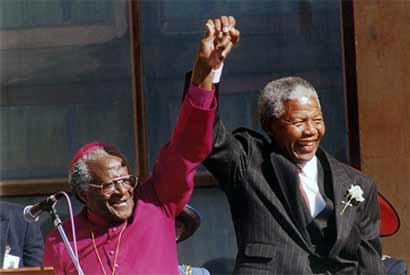SOWETO
To leave Botswana, we had to connect through Johannesburg. We had less than 24 hours there, and took advantage of our limited time by touring the neighborhood of Soweto. We were in the very good company of T.K., the most passionate, engaging, and knowledgeable guide, who told us the incredible and heartbreaking history of Soweto. Our whole family wanted to share what we learned:
ERIN: Soweto stands for South Western Township. It is an area in Johannesburg where Black people were forced to live during apartheid.
REESE: Nelson Mandela and Archbishop Desmond Tutu were two people who lived there. They were very good people and always agreed on everything together.
HARPER: This is the only neighborhood in the world that is home to two Nobel Peace Prize winners.
CHRIS: The incredibly important — and terrifying — history of Soweto didn’t happen hundreds of years ago. The history of Soweto is a recent history.
ERIN: The Mandela House is a small red brick building where Nelson lived with his wife and daughters before he was arrested and jailed for 27 years.
REESE: At the time when they lived there, it was very scary. You can see bullet holes in the walls.
HARPER: They built a wall inside their home to hide behind, to stop the bullets from hitting them.
CHRIS: It’s terrifying that Mandela’s family had to build that wall inside the house. Imagine that. In your home.
SADIE: Their house was set on fire multiple times — by. the. police.
ERIN: Desmond Tutu‘s house was only 200 steps away from Mandela’s.
REESE: His family is still living in the house today.
CHRIS: I love it that his family is still there, and that he always came back because of his commitment to Soweto and to South Africa.
ERIN: Very soon after Nelson Mandela got out of prison, he met with Desmond Tutu.
REESE: They spent the whole night talking about stuff.
ERIN: Desmond Tutu wanted to move forward and make South Africa a “rainbow nation,” where diverse cultures, religions, and communities could coexist peacefully.
SADIE: Mandela and his wife, Winnie, separated because they had different opinions on things.
REESE: Mandela believed in forgiveness.
HARPER: Winnie, on the other hand, believed in punishing the people who had terrorized their children and treated them wrongly.
ERIN: We visited the site of the Soweto Uprising, where students protested against the apartheid regime on June 16, 1976. There is now a museum and a memorial here.
CHRIS: The story of Hector Pieterson and all the other students on that day is heartbreaking and unfathomable.
SADIE: The apartheid government said that school lessons must be taught to black students in a language they did not understand.
ERIN: So their plan was to march down the road to the Board of Education offices, with a petition that implored the adults to let them be taught in their native language of Zulu.
HARPER: The police came and shot them.
REESE: The youngest person who was killed was a 12-year-old boy.
CHRIS: It’s terrifying and sad and upsetting and makes me angry and it makes me cry all at once.
ERIN: I don’t understand why humans treat each other this way.












